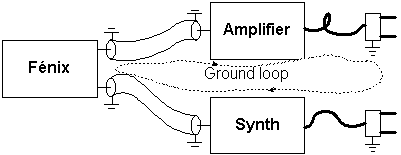IT Solution & IT Startup
Intro.
This section covers connecting the Fenix to other devices. Some signal conversion or gain change may be needed:
Midi-signal to CV's and gates.
Level adjustment of an audio signal that feeds into an amplifier.
Converting audio signals to control voltages.
In unbalanced connections, there are two signals to connect devices: Signal and ground. These are usually both in the connector. Fenix banana-patch cords use only the signal, so they are not suitable for connecting to other devices.There are also balanced audio connections. These have +signal, -signal and a ground lead. Since the Fenix doesn't use balanced connections, we will not cover these. Most professional recording studio's use balanced cables for critical and low-level connections. The Fenix has very high output levels to keep a good signal to noise ratio. Please keep this in mind while connecting it to a mixer.Improper ground connections may be the cause of ground loops resulting in hum. This is why the first section deals with grounding.
This section also covers Midi interface and audio interfacing.
Ground is used everywhere in any audio setup. Ideally, the ground should be the same throughout the setup.
The ground is used as reference by power supplies and audio connections. If several devices are interconnected using (shielded) grounded cables and the PSU is mains-grounded, you may have a ground loop. This can result in current flowing between devices like PSU and audio input which may cause the typical 50 or 60 Hz hum.
In the picture below, a ground loop is caused by connecting a Fenix to two mains-grounded devices. The loop is closed by the ground-wire of the mains network.
It is not always easy to provide a solution for ground loops.One possible way is to decouple the signals using 1:1 transformers, but this is an expensive approach. To prevent the risk of ground loops whenever you change your setup it makes sense to design a ground-setup for your entire setup or studio.Another common approach is to have all outputs ungrounded and only connect the cable-shields at the input-side. A separate ground-lead on each device leads to a central ground-point. If you choose this method, you'll have to run a ground-lead from each device to the ground-point. This may be a problem if you mix grounded and ungrounded devices in the same setup.A third way is to feed all grounded devices from a properly grounded outlet, and run a ground-lead from each ungrounded device to the ground-point of one grounded device.If no mains-grounding is used, it is advisable to not use power-strips with grounded outlets. This may create a ground loop through the power-cables.
Devices that use switched power supplies ( such as most computers) may pose another problem. The grounding is an integral part of the mains-filter. It is advisable to connect these to a grounded outlet.There is no cut and dry way to deal with grounding, and it is important to realize how easily you can create one. You may have to experiment to find the solution that works best for you.
